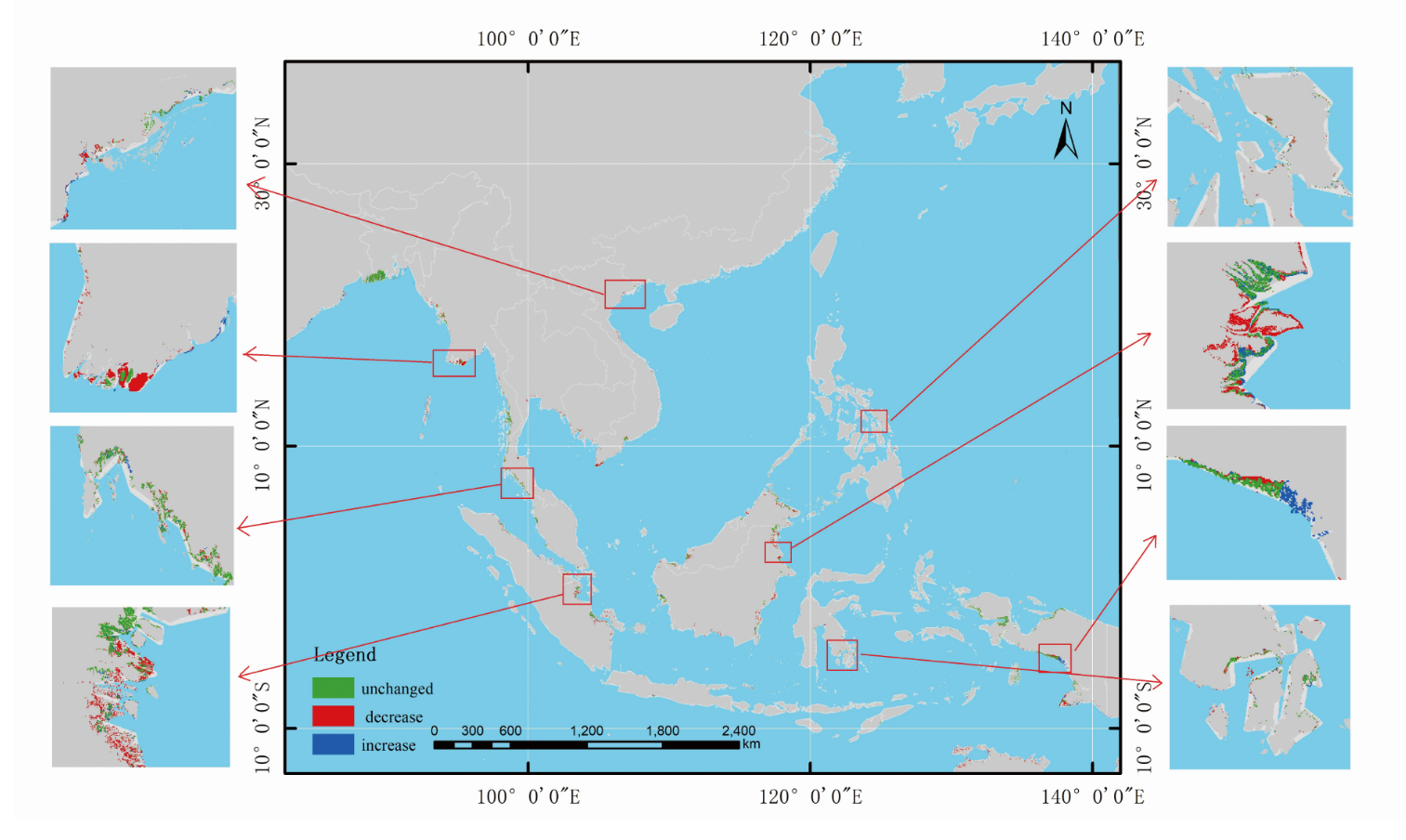SDG6: Clean Water and Sanitation
Mapping the extent and dynamic change of mangrove forests in Southeast Asia(2019)
Scale: Regional




Study area: Southeast Asia
Mangrove forests are swampy woody plant communities that grow on the intertidal zone of tropical and subtropical coasts. They have special sea-land characteristics and enormous ecological, economic, and social benefits. Mangrove forests play an important role in highlighting global climate and environmental changes. Additionally, they are important for maintaining biodiversity, protecting coastal environments, purifying coastal waters, and protecting farmland and villages from natural disasters such as hurricanes and tsunamis.
The distribution of mangroves along the Maritime Silk Road accounts for more than half of the world's total mangrove forest area. They are mostly located in tropical-subtropical regions with Southeast Asia having a large mangrove forest area. Currently, mangrove forests in the coastal areas of Southeast Asia are under threat from ecological disturbances and are experiencing continuous degradation.
Target 6.6: By 2030, protect and restore water-related ecosystems, including mountains, forests, wetlands, rivers, aquifers, and lakes.
Indicator 6.6.1: Change in the extent of water-related ecosystems over time.
Method
This case study employed long-term time series remote sensing data obtained from Landsat satellites to monitor dynamic changes in mangrove forests in Southeast Asia from 1990 to 2015. The satellite images were first pre-processed using radiometric calibration, and atmospheric correction and registration. The mangrove areas were then identified using their spectral characteristics, textural features, and spatial configuration with references from Google Earth images for the same period. These areas were then vectorized and mapped. The results of this study were compared with the existing mangrove datasets provided by FAO and World Mangrove Forests (WMF).
Data used in the case
A total of 1,836 Landsat Thematic Mapper (TM) and Enhanced Thematic Mapper Plus (ETM+) images from 1990 to 2015 were used for long-term change monitoring of mangrove forests.
FAO and WMF mangrove datasets were used to verify the accuracy of results.
Results and analysis
The top three countries with the largest area of mangroves in Southeast Asia were Indonesia (68%), Malaysia (10%), and Myanmar (9%) (Figure 2). During the period from 1990 to 2015, the area of mangrove forests in Southeast Asia revealed a decreasing trend (Figure 1). The mangrove areas in Vietnam, the Philippines, Thailand, Myanmar, Indonesia, Malaysia, and Cambodia were observed to continue to decrease, while the areas in Singapore remained unchanged. China's mangrove area was observed to slightly increase in recent years. (Figure 2).

Figure 1. The change in mangrove area in Southeast Asia from 1990 to 2015.
The mangrove forest area in Southeast Asia was observed to decrease from 1990 to 2015, especially in Vietnam, the Philippines, Thailand, Myanmar, Indonesia, Malaysia, and Cambodia. This was caused by the rapid economic development in Southeast Asia, especially in Vietnam and Thailand. Aquaculture has been vigorously developed, resulting in the accelerated loss of mangrove wetlands and their transformation into aquaculture ponds. Meanwhile, aquaculture has enabled environmental pollution, further damaging mangrove wetland habitats and decreasing their total surface area. Conversely, China's mangrove area has been observed to be increasing in recent years, reflecting the nation's emphasis on ecological and environmental protection, and implementation of relevant policies. Such policies include returning ponds to forests and wetlands, which leads to an increase in the area of mangrove wetlands.


Figure 2. Distribution and change in mangrove area in Southeast Asian countries from 1990 to 2015.
| Highlights |
| During the period from 1990 to 2015, the area of mangrove forests in Southeast Asia has revealed a decreasing trend. The mangrove areas in Vietnam, the Philippines, Thailand, Myanmar, Indonesia, Malaysia, and Cambodia continue to decrease, while the area in Singapore remains unchanged. China's mangrove area has slightly increased in recentyears. Recently, the area of mangrove forests in China has shown an increasing trend, reflecting the effectiveness of conservation measures such as returning ponds to forests and wetlands. |
Outlook
Mangrove wetlands are open, fragile, and complex ecosystems. They grow in coastal areas where economic development occurs at a rapid pace. In addition to the influence of natural factors, human activities directly and indirectly affect the growth, distribution, health, and diversity of mangrove forests. The dynamic change in mangrove area reflects human activity such as the restoration and protection of mangroves, and their encroachment and use. Moreover, the change in mangrove area is directly linked to economic and social sustainable development and the implementation of relevant policies. Future developments will involve a focus on the following aspects.
(1)Mangrove forests will be monitored using multi-source remote sensing data. High-resolution, hyperspectral, and radar remote sensing data will be used for monitoring mangrove forests. Moreover, deep-learning methods will be used to enhance the identification and extraction of mangrove forests from remote sensing imagery.
(2)There will be a focus on providing data and information support for the protection, restoration, and rational use of mangrove resources in the region.

Mangrove forest

